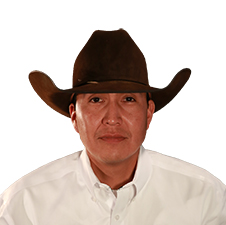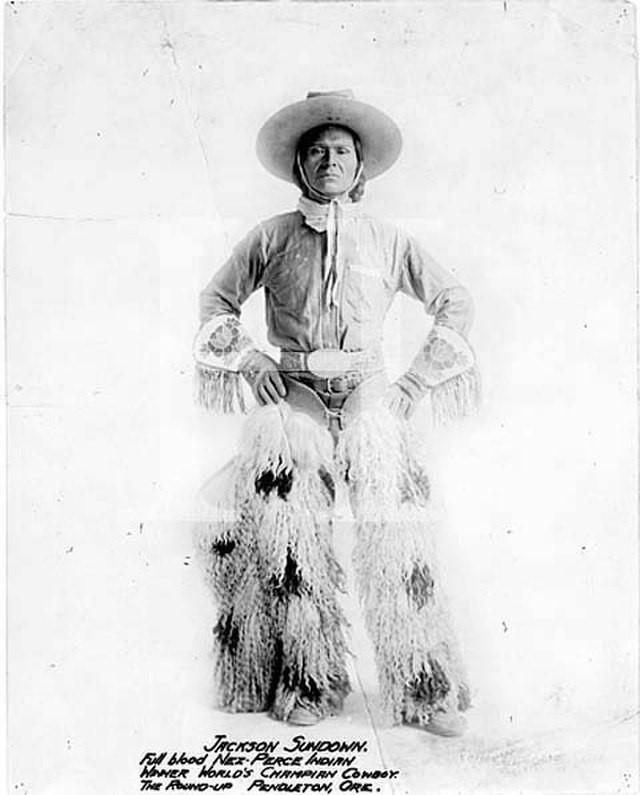Editor’s Note: Anna Dean, Collections Technician, highlights the Indigenous influences found in a cultural phenomenon known as the rodeo.
It’s Rodeo season in Houston, which means that dozens of athletes from across the United States and Canada will be competing in events like steer wrestling, barrel racing, and bull riding. Among these contestants are three Navajo competitors – Derrick Begay, Erich Rogers, and Aaron Tsinigine. Among the best team ropers in the world, most recently Tsinigine placed second in the finals of the San Antonio Stock Show and Rodeo with a time of 4.3 seconds.



Indigenous involvement in rodeo competitions traces back to the inception of the sport. Rodeos began as early as the 1570s, a practice to gather cattle herds to central location for branding and sale. A social gathering as well as a business event, during this time vaqueros (what we now call cowboys), employed by cattle ranchers, would display skills such as roping or wrestling cattle. Many vaqueros were black, mixed Spanish and Mexican Indigenous, and American Indigenous.
As more European Americans immigrated to the U.S., displays of these talents began to draw crowds. Traveling shows such as Buffalo Bill’s and Pecos Bill’s Wild West Shows brought these events to audiences across the country in the second half of the 19th century, paying cowboys to perform feats traditional to rodeos. Around this time, competitive rodeos began to become regular events, where cowboys would participate in contests for prize money.

One of the earliest and most famous Indigenous rodeo stars was Nez Perce Waaya-Tonah-Toesits-Kahn, also called Jackson Sundown. Sundown performed in rodeos throughout his youth, but his final ride on a saddle bronc in 1915 at the age of 52 made him the champion of the Pendleton Round-Up, and immortalized him as one of the greatest bronc riders to participate in the sport.
After World War One, powerful rodeo promoters such as Tex Austin and William Johnson monopolized the sport, instituting powerful committees that judged the events and often excluded non-white athletes from qualifying for prize money. As a result, Indigenous athletes founded their own events and their own coalitions, including the Central Navajo Rodeo Association and the All Indian Rodeo Cowboys Association (AIRCA). Although today many organizations welcome and encourage Indigenous participation, ‘Indian Rodeo’ is still an important cultural institution for Indigenous groups, culminating every year in the Indian National Finals Rodeo (INFR). Houston Rodeo competitors Derrick Begay won the all-around title at the 2007 INFR. Erich Rogers won the all-around at the AIRCA Championship Rodeo in 2008. Together, Rogers and Aaron Tsinigine won the 2010 AIRCA Championship Rodeo.

Derrick Begay has already begun competing in the Houston Rodeo, finishing fourth place in round 1 of the Super Series III with a time of 6.2 seconds. Erich Rogers and Aaron Tsinigine will compete in Super Series V beginning March 12th. All three athletes are trying to be in the top four of their event, which will advance them to the semifinals, which begin March 15th.
Throughout the history of rodeo, Indigenous influence and participation has been a vital part of this cultural institution. Although rodeos appear much differently now than they did in the days of the earliest vaqueros, athletes like Begay, Rogers, and Tsinigine continue to represent their community’s contribution to this sport on the national stage, while making their own individual contributions to the world of rodeo.
Learn more about the influence of Indigenous peoples and cultures in our recently renovated John P. McGovern Hall of the Americas.
More from the Collections Team
From Our Collections: Lucy is in the Building
From our Collections: You Should See Me in a Crown – The Queen Conch






